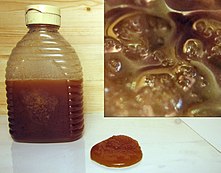Crystalline

|

|
|
|
Links: Broken sawed and polished Achatdruse with cryptocrystalline (outside) and macrocrystalline (s) quartz
Right: honey (essentially a mixture of monosaccharides ) in stage advanced crystallization |
||
As crystalline refers to solids , consisting of crystallized consist material. The opposite is amorphous .
In the geological and related sciences, inorganic , natural crystalline substances - minerals and rocks - are the subject of research. In petrography, a distinction is made between macrocrystalline (coarsely crystalline), microcrystalline (finely crystalline) and cryptocrystalline (dense) rocks. Macrocrystalline rocks show individual "crystals" (usually called grains , cf. crystallite ) at first glance (e.g. feldspars , quartz and mica in granite ), while microcrystalline , certain limestones or volcanic rocks e.g. B., only become visible under a magnifying glass or a light microscope . In the case of cryptocrystalline rock ( e.g. flint ), the crystals can no longer be resolved even with the aid of a light microscope.
In addition to the terms crystalline and amorphous, the term partially crystalline is also used in polymer physics . Commercially available sugar (sucrose), not a polymer , is a well-known example of an organic substance that can exist in crystalline form.
Individual evidence
- ^ H. Murawski, W. Meyer: Geological dictionary. 11th edition. Spectrum Academic Publishing House, 2004, ISBN 3-8274-1445-8 .